Analysis of Investment Options: Payback, NPV, and Decision Making
VerifiedAdded on 2023/01/11
|8
|1482
|44
Report
AI Summary
This report delves into the application of Net Present Value (NPV) and payback period techniques for analyzing investment opportunities. It begins with an introduction to both methods, followed by detailed calculations for Project A and Project B, demonstrating how to determine the payback period and NPV for each. The report then compares the advantages and disadvantages of each method, highlighting the ease of use and liquidity benefits of the payback period, as well as the time value of money consideration in NPV. The report then identifies and evaluates the impact of financial and non-financial factors on business decision-making, underscoring the importance of considering both types of factors for overall organizational growth. The analysis concludes by affirming the effectiveness of the NPV method over the payback period, while acknowledging the utility of both in making informed investment choices.

BUSINESS DECISION
MAKING
MAKING
Paraphrase This Document
Need a fresh take? Get an instant paraphrase of this document with our AI Paraphraser
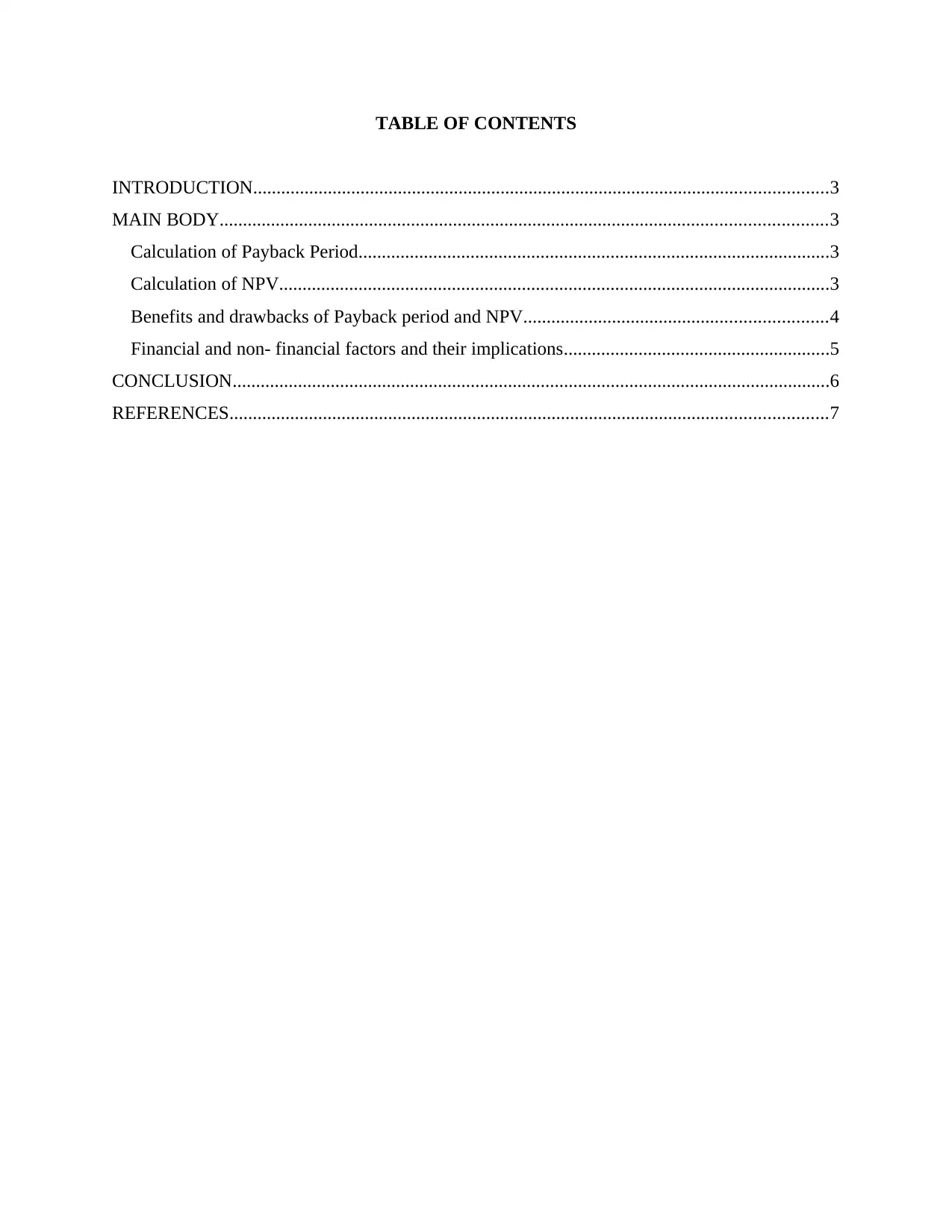
TABLE OF CONTENTS
INTRODUCTION...........................................................................................................................3
MAIN BODY..................................................................................................................................3
Calculation of Payback Period.....................................................................................................3
Calculation of NPV......................................................................................................................3
Benefits and drawbacks of Payback period and NPV.................................................................4
Financial and non- financial factors and their implications.........................................................5
CONCLUSION................................................................................................................................6
REFERENCES................................................................................................................................7
INTRODUCTION...........................................................................................................................3
MAIN BODY..................................................................................................................................3
Calculation of Payback Period.....................................................................................................3
Calculation of NPV......................................................................................................................3
Benefits and drawbacks of Payback period and NPV.................................................................4
Financial and non- financial factors and their implications.........................................................5
CONCLUSION................................................................................................................................6
REFERENCES................................................................................................................................7
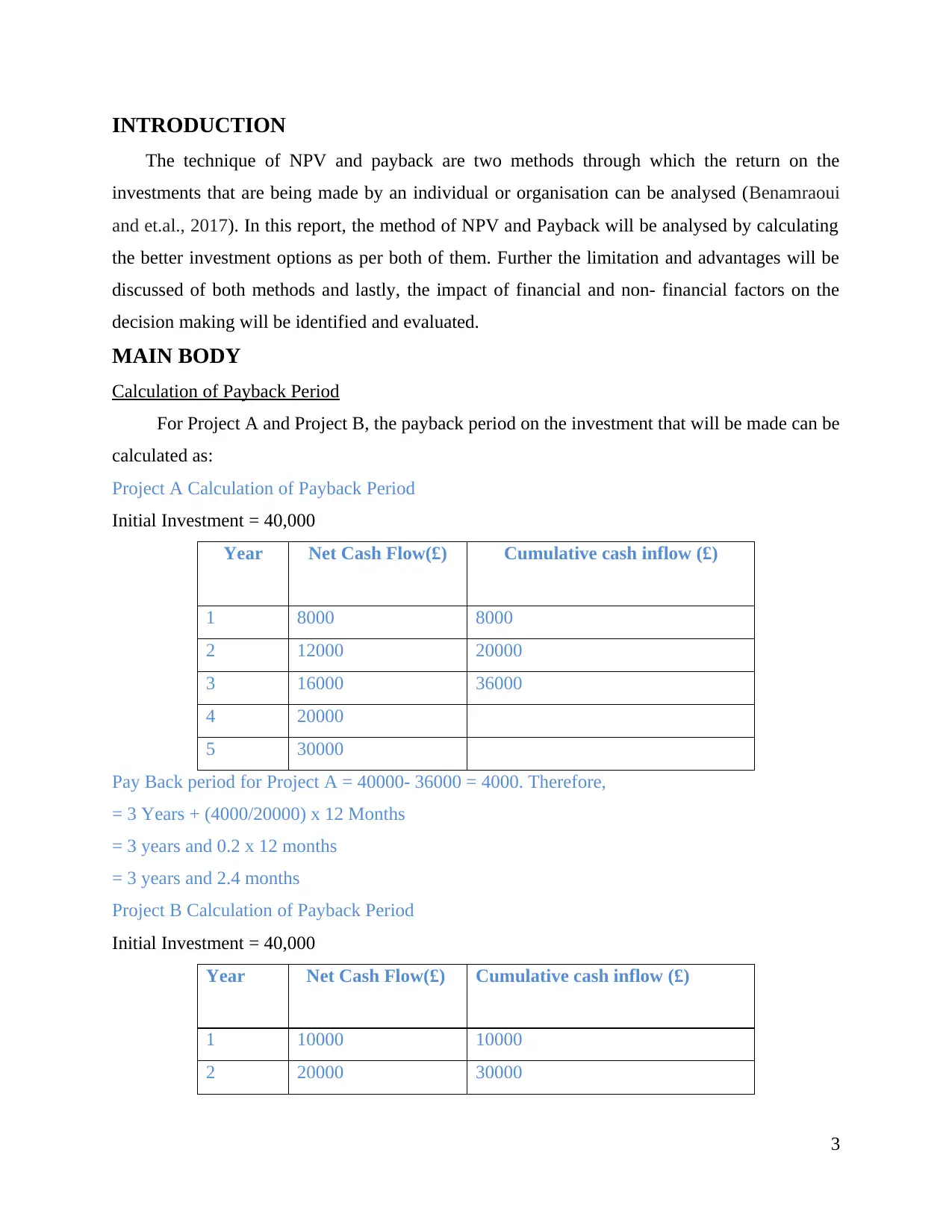
INTRODUCTION
The technique of NPV and payback are two methods through which the return on the
investments that are being made by an individual or organisation can be analysed (Benamraoui
and et.al., 2017). In this report, the method of NPV and Payback will be analysed by calculating
the better investment options as per both of them. Further the limitation and advantages will be
discussed of both methods and lastly, the impact of financial and non- financial factors on the
decision making will be identified and evaluated.
MAIN BODY
Calculation of Payback Period
For Project A and Project B, the payback period on the investment that will be made can be
calculated as:
Project A Calculation of Payback Period
Initial Investment = 40,000
Year Net Cash Flow(£) Cumulative cash inflow (£)
1 8000 8000
2 12000 20000
3 16000 36000
4 20000
5 30000
Pay Back period for Project A = 40000- 36000 = 4000. Therefore,
= 3 Years + (4000/20000) x 12 Months
= 3 years and 0.2 x 12 months
= 3 years and 2.4 months
Project B Calculation of Payback Period
Initial Investment = 40,000
Year Net Cash Flow(£) Cumulative cash inflow (£)
1 10000 10000
2 20000 30000
3
The technique of NPV and payback are two methods through which the return on the
investments that are being made by an individual or organisation can be analysed (Benamraoui
and et.al., 2017). In this report, the method of NPV and Payback will be analysed by calculating
the better investment options as per both of them. Further the limitation and advantages will be
discussed of both methods and lastly, the impact of financial and non- financial factors on the
decision making will be identified and evaluated.
MAIN BODY
Calculation of Payback Period
For Project A and Project B, the payback period on the investment that will be made can be
calculated as:
Project A Calculation of Payback Period
Initial Investment = 40,000
Year Net Cash Flow(£) Cumulative cash inflow (£)
1 8000 8000
2 12000 20000
3 16000 36000
4 20000
5 30000
Pay Back period for Project A = 40000- 36000 = 4000. Therefore,
= 3 Years + (4000/20000) x 12 Months
= 3 years and 0.2 x 12 months
= 3 years and 2.4 months
Project B Calculation of Payback Period
Initial Investment = 40,000
Year Net Cash Flow(£) Cumulative cash inflow (£)
1 10000 10000
2 20000 30000
3
⊘ This is a preview!⊘
Do you want full access?
Subscribe today to unlock all pages.

Trusted by 1+ million students worldwide
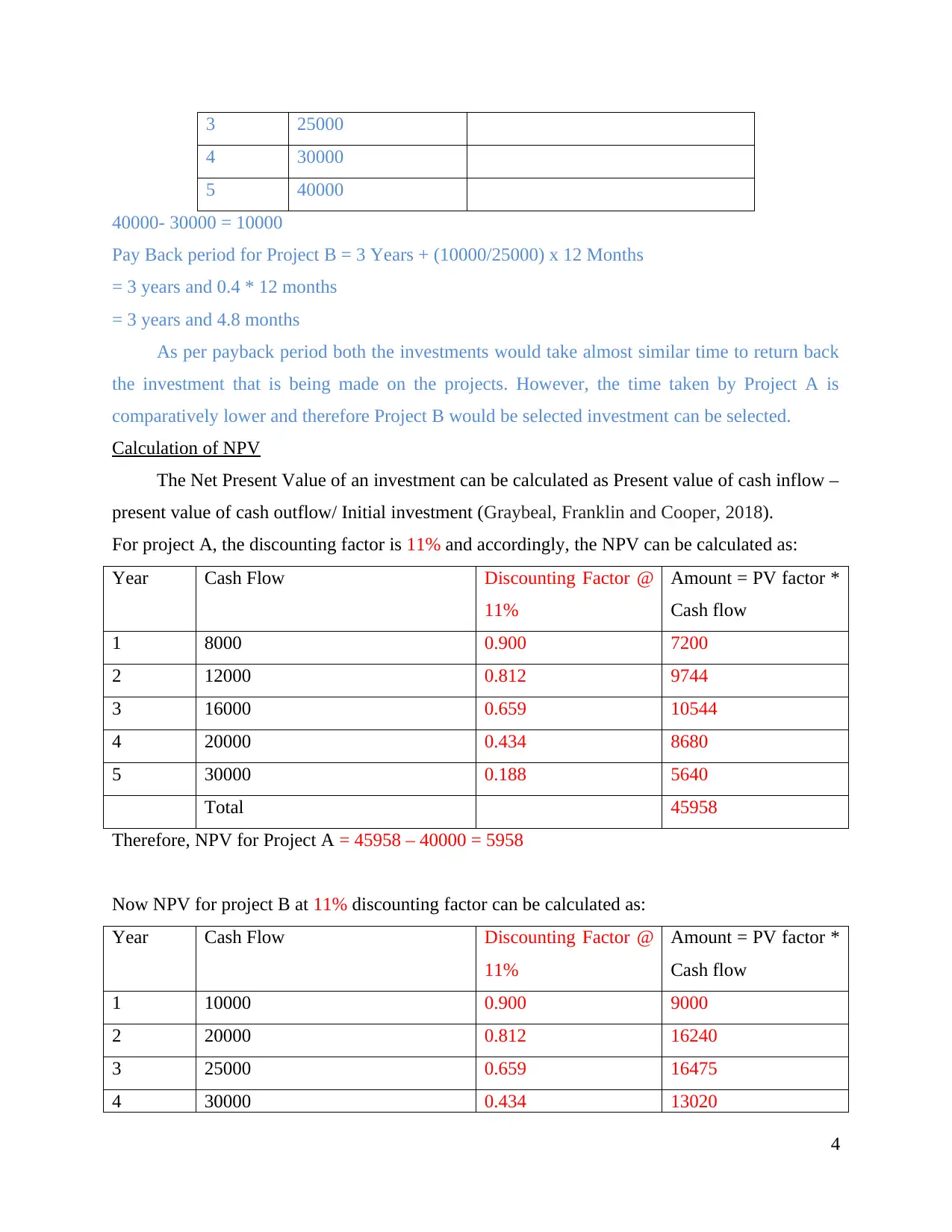
3 25000
4 30000
5 40000
40000- 30000 = 10000
Pay Back period for Project B = 3 Years + (10000/25000) x 12 Months
= 3 years and 0.4 * 12 months
= 3 years and 4.8 months
As per payback period both the investments would take almost similar time to return back
the investment that is being made on the projects. However, the time taken by Project A is
comparatively lower and therefore Project B would be selected investment can be selected.
Calculation of NPV
The Net Present Value of an investment can be calculated as Present value of cash inflow –
present value of cash outflow/ Initial investment (Graybeal, Franklin and Cooper, 2018).
For project A, the discounting factor is 11% and accordingly, the NPV can be calculated as:
Year Cash Flow Discounting Factor @
11%
Amount = PV factor *
Cash flow
1 8000 0.900 7200
2 12000 0.812 9744
3 16000 0.659 10544
4 20000 0.434 8680
5 30000 0.188 5640
Total 45958
Therefore, NPV for Project A = 45958 – 40000 = 5958
Now NPV for project B at 11% discounting factor can be calculated as:
Year Cash Flow Discounting Factor @
11%
Amount = PV factor *
Cash flow
1 10000 0.900 9000
2 20000 0.812 16240
3 25000 0.659 16475
4 30000 0.434 13020
4
4 30000
5 40000
40000- 30000 = 10000
Pay Back period for Project B = 3 Years + (10000/25000) x 12 Months
= 3 years and 0.4 * 12 months
= 3 years and 4.8 months
As per payback period both the investments would take almost similar time to return back
the investment that is being made on the projects. However, the time taken by Project A is
comparatively lower and therefore Project B would be selected investment can be selected.
Calculation of NPV
The Net Present Value of an investment can be calculated as Present value of cash inflow –
present value of cash outflow/ Initial investment (Graybeal, Franklin and Cooper, 2018).
For project A, the discounting factor is 11% and accordingly, the NPV can be calculated as:
Year Cash Flow Discounting Factor @
11%
Amount = PV factor *
Cash flow
1 8000 0.900 7200
2 12000 0.812 9744
3 16000 0.659 10544
4 20000 0.434 8680
5 30000 0.188 5640
Total 45958
Therefore, NPV for Project A = 45958 – 40000 = 5958
Now NPV for project B at 11% discounting factor can be calculated as:
Year Cash Flow Discounting Factor @
11%
Amount = PV factor *
Cash flow
1 10000 0.900 9000
2 20000 0.812 16240
3 25000 0.659 16475
4 30000 0.434 13020
4
Paraphrase This Document
Need a fresh take? Get an instant paraphrase of this document with our AI Paraphraser
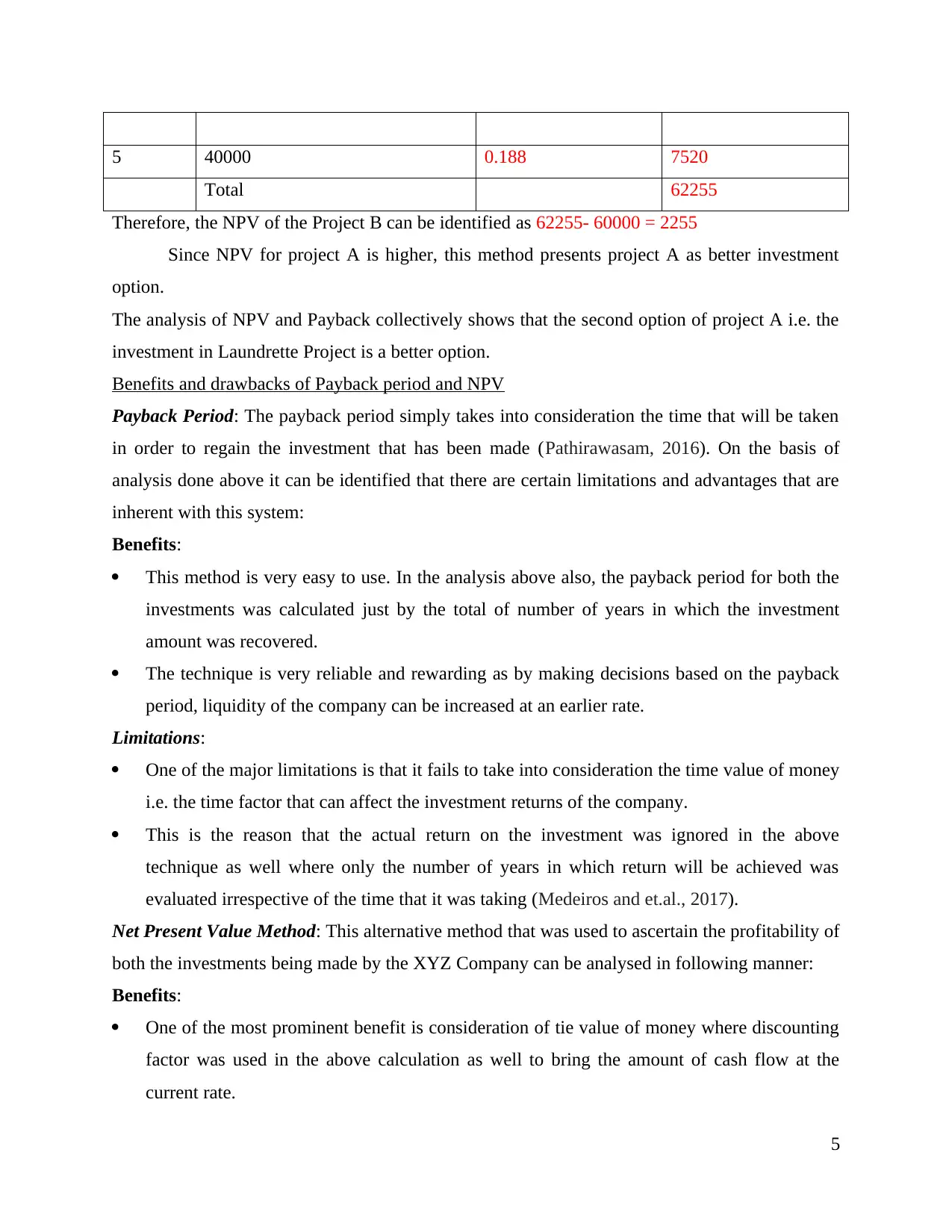
5 40000 0.188 7520
Total 62255
Therefore, the NPV of the Project B can be identified as 62255- 60000 = 2255
Since NPV for project A is higher, this method presents project A as better investment
option.
The analysis of NPV and Payback collectively shows that the second option of project A i.e. the
investment in Laundrette Project is a better option.
Benefits and drawbacks of Payback period and NPV
Payback Period: The payback period simply takes into consideration the time that will be taken
in order to regain the investment that has been made (Pathirawasam, 2016). On the basis of
analysis done above it can be identified that there are certain limitations and advantages that are
inherent with this system:
Benefits:
This method is very easy to use. In the analysis above also, the payback period for both the
investments was calculated just by the total of number of years in which the investment
amount was recovered.
The technique is very reliable and rewarding as by making decisions based on the payback
period, liquidity of the company can be increased at an earlier rate.
Limitations:
One of the major limitations is that it fails to take into consideration the time value of money
i.e. the time factor that can affect the investment returns of the company.
This is the reason that the actual return on the investment was ignored in the above
technique as well where only the number of years in which return will be achieved was
evaluated irrespective of the time that it was taking (Medeiros and et.al., 2017).
Net Present Value Method: This alternative method that was used to ascertain the profitability of
both the investments being made by the XYZ Company can be analysed in following manner:
Benefits:
One of the most prominent benefit is consideration of tie value of money where discounting
factor was used in the above calculation as well to bring the amount of cash flow at the
current rate.
5
Total 62255
Therefore, the NPV of the Project B can be identified as 62255- 60000 = 2255
Since NPV for project A is higher, this method presents project A as better investment
option.
The analysis of NPV and Payback collectively shows that the second option of project A i.e. the
investment in Laundrette Project is a better option.
Benefits and drawbacks of Payback period and NPV
Payback Period: The payback period simply takes into consideration the time that will be taken
in order to regain the investment that has been made (Pathirawasam, 2016). On the basis of
analysis done above it can be identified that there are certain limitations and advantages that are
inherent with this system:
Benefits:
This method is very easy to use. In the analysis above also, the payback period for both the
investments was calculated just by the total of number of years in which the investment
amount was recovered.
The technique is very reliable and rewarding as by making decisions based on the payback
period, liquidity of the company can be increased at an earlier rate.
Limitations:
One of the major limitations is that it fails to take into consideration the time value of money
i.e. the time factor that can affect the investment returns of the company.
This is the reason that the actual return on the investment was ignored in the above
technique as well where only the number of years in which return will be achieved was
evaluated irrespective of the time that it was taking (Medeiros and et.al., 2017).
Net Present Value Method: This alternative method that was used to ascertain the profitability of
both the investments being made by the XYZ Company can be analysed in following manner:
Benefits:
One of the most prominent benefit is consideration of tie value of money where discounting
factor was used in the above calculation as well to bring the amount of cash flow at the
current rate.
5
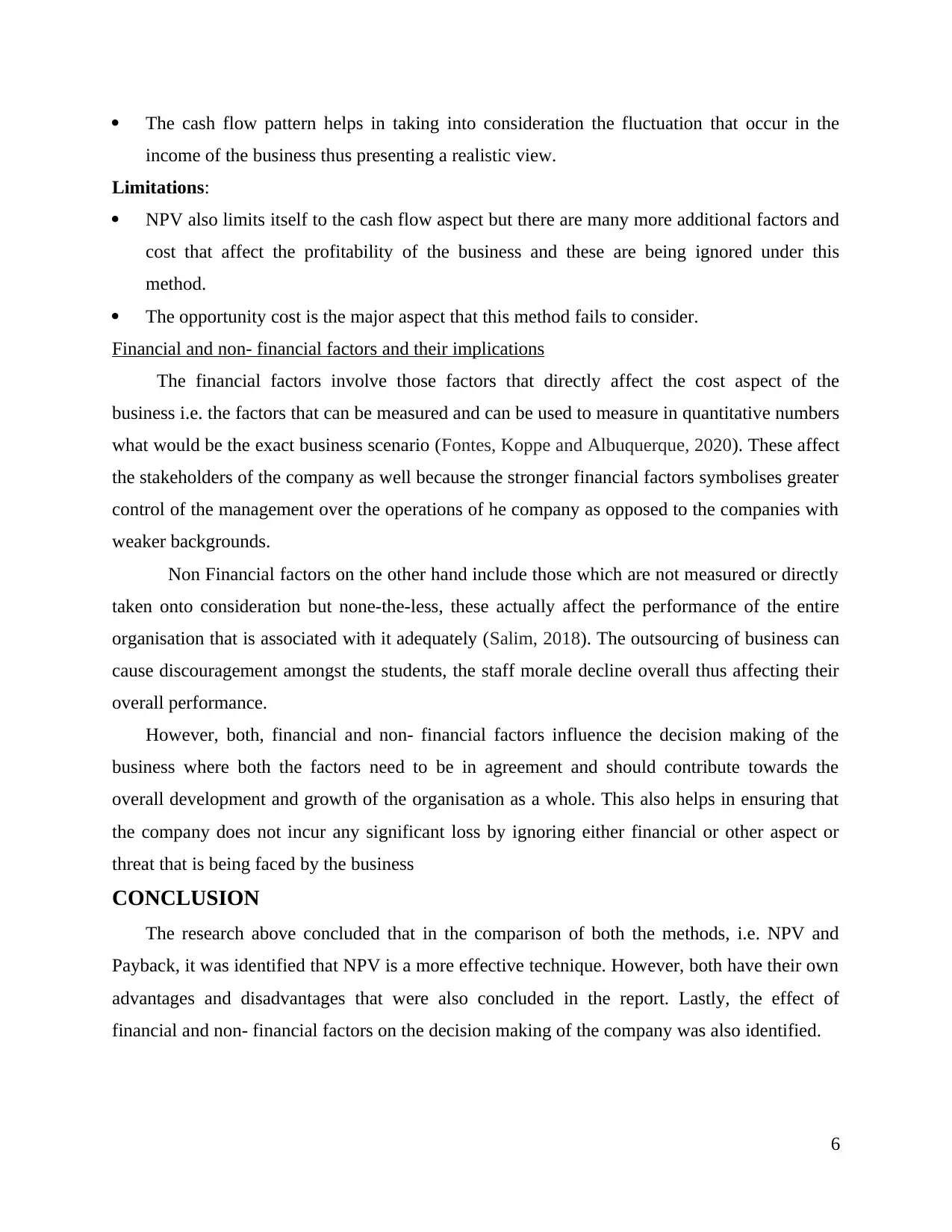
The cash flow pattern helps in taking into consideration the fluctuation that occur in the
income of the business thus presenting a realistic view.
Limitations:
NPV also limits itself to the cash flow aspect but there are many more additional factors and
cost that affect the profitability of the business and these are being ignored under this
method.
The opportunity cost is the major aspect that this method fails to consider.
Financial and non- financial factors and their implications
The financial factors involve those factors that directly affect the cost aspect of the
business i.e. the factors that can be measured and can be used to measure in quantitative numbers
what would be the exact business scenario (Fontes, Koppe and Albuquerque, 2020). These affect
the stakeholders of the company as well because the stronger financial factors symbolises greater
control of the management over the operations of he company as opposed to the companies with
weaker backgrounds.
Non Financial factors on the other hand include those which are not measured or directly
taken onto consideration but none-the-less, these actually affect the performance of the entire
organisation that is associated with it adequately (Salim, 2018). The outsourcing of business can
cause discouragement amongst the students, the staff morale decline overall thus affecting their
overall performance.
However, both, financial and non- financial factors influence the decision making of the
business where both the factors need to be in agreement and should contribute towards the
overall development and growth of the organisation as a whole. This also helps in ensuring that
the company does not incur any significant loss by ignoring either financial or other aspect or
threat that is being faced by the business
CONCLUSION
The research above concluded that in the comparison of both the methods, i.e. NPV and
Payback, it was identified that NPV is a more effective technique. However, both have their own
advantages and disadvantages that were also concluded in the report. Lastly, the effect of
financial and non- financial factors on the decision making of the company was also identified.
6
income of the business thus presenting a realistic view.
Limitations:
NPV also limits itself to the cash flow aspect but there are many more additional factors and
cost that affect the profitability of the business and these are being ignored under this
method.
The opportunity cost is the major aspect that this method fails to consider.
Financial and non- financial factors and their implications
The financial factors involve those factors that directly affect the cost aspect of the
business i.e. the factors that can be measured and can be used to measure in quantitative numbers
what would be the exact business scenario (Fontes, Koppe and Albuquerque, 2020). These affect
the stakeholders of the company as well because the stronger financial factors symbolises greater
control of the management over the operations of he company as opposed to the companies with
weaker backgrounds.
Non Financial factors on the other hand include those which are not measured or directly
taken onto consideration but none-the-less, these actually affect the performance of the entire
organisation that is associated with it adequately (Salim, 2018). The outsourcing of business can
cause discouragement amongst the students, the staff morale decline overall thus affecting their
overall performance.
However, both, financial and non- financial factors influence the decision making of the
business where both the factors need to be in agreement and should contribute towards the
overall development and growth of the organisation as a whole. This also helps in ensuring that
the company does not incur any significant loss by ignoring either financial or other aspect or
threat that is being faced by the business
CONCLUSION
The research above concluded that in the comparison of both the methods, i.e. NPV and
Payback, it was identified that NPV is a more effective technique. However, both have their own
advantages and disadvantages that were also concluded in the report. Lastly, the effect of
financial and non- financial factors on the decision making of the company was also identified.
6
⊘ This is a preview!⊘
Do you want full access?
Subscribe today to unlock all pages.

Trusted by 1+ million students worldwide
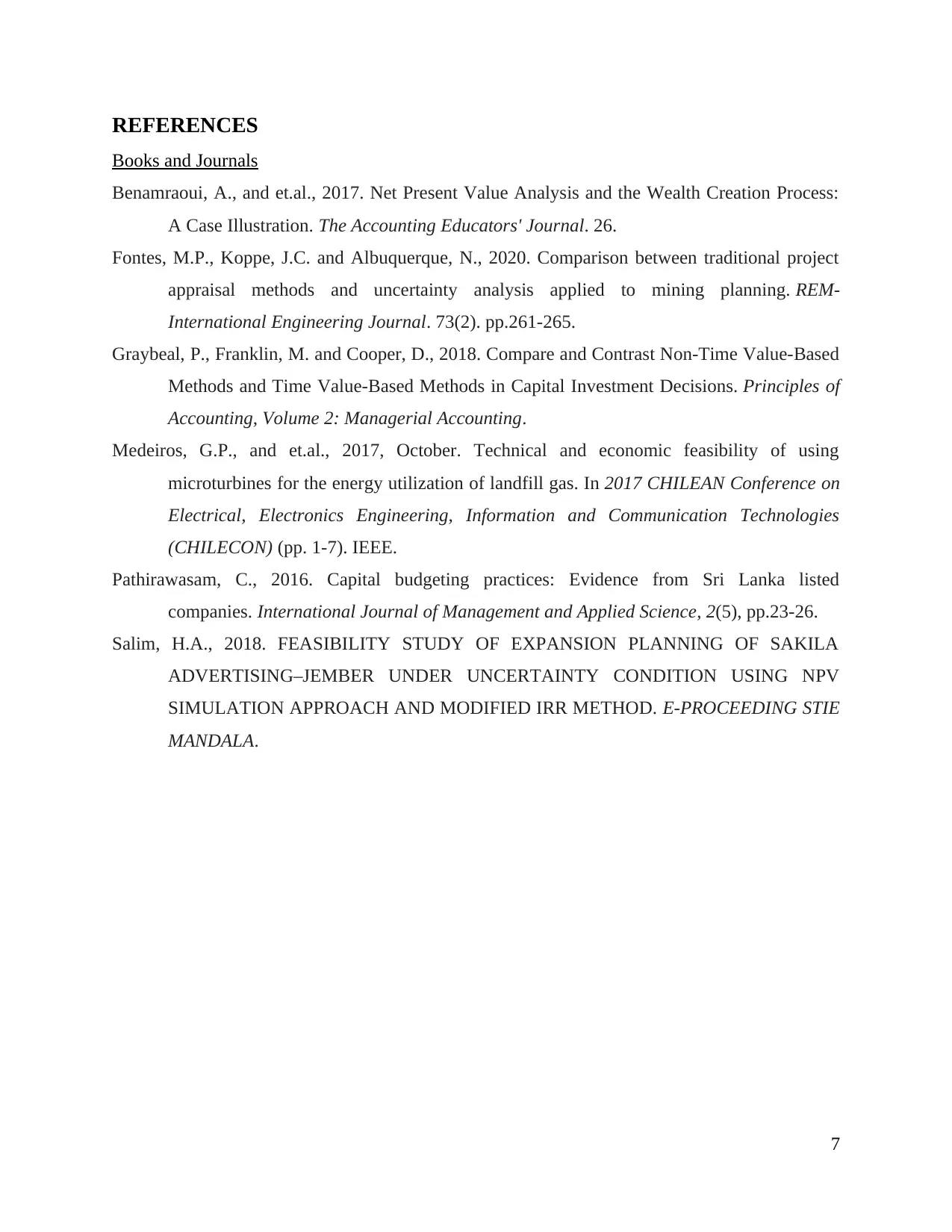
REFERENCES
Books and Journals
Benamraoui, A., and et.al., 2017. Net Present Value Analysis and the Wealth Creation Process:
A Case Illustration. The Accounting Educators' Journal. 26.
Fontes, M.P., Koppe, J.C. and Albuquerque, N., 2020. Comparison between traditional project
appraisal methods and uncertainty analysis applied to mining planning. REM-
International Engineering Journal. 73(2). pp.261-265.
Graybeal, P., Franklin, M. and Cooper, D., 2018. Compare and Contrast Non-Time Value-Based
Methods and Time Value-Based Methods in Capital Investment Decisions. Principles of
Accounting, Volume 2: Managerial Accounting.
Medeiros, G.P., and et.al., 2017, October. Technical and economic feasibility of using
microturbines for the energy utilization of landfill gas. In 2017 CHILEAN Conference on
Electrical, Electronics Engineering, Information and Communication Technologies
(CHILECON) (pp. 1-7). IEEE.
Pathirawasam, C., 2016. Capital budgeting practices: Evidence from Sri Lanka listed
companies. International Journal of Management and Applied Science, 2(5), pp.23-26.
Salim, H.A., 2018. FEASIBILITY STUDY OF EXPANSION PLANNING OF SAKILA
ADVERTISING–JEMBER UNDER UNCERTAINTY CONDITION USING NPV
SIMULATION APPROACH AND MODIFIED IRR METHOD. E-PROCEEDING STIE
MANDALA.
7
Books and Journals
Benamraoui, A., and et.al., 2017. Net Present Value Analysis and the Wealth Creation Process:
A Case Illustration. The Accounting Educators' Journal. 26.
Fontes, M.P., Koppe, J.C. and Albuquerque, N., 2020. Comparison between traditional project
appraisal methods and uncertainty analysis applied to mining planning. REM-
International Engineering Journal. 73(2). pp.261-265.
Graybeal, P., Franklin, M. and Cooper, D., 2018. Compare and Contrast Non-Time Value-Based
Methods and Time Value-Based Methods in Capital Investment Decisions. Principles of
Accounting, Volume 2: Managerial Accounting.
Medeiros, G.P., and et.al., 2017, October. Technical and economic feasibility of using
microturbines for the energy utilization of landfill gas. In 2017 CHILEAN Conference on
Electrical, Electronics Engineering, Information and Communication Technologies
(CHILECON) (pp. 1-7). IEEE.
Pathirawasam, C., 2016. Capital budgeting practices: Evidence from Sri Lanka listed
companies. International Journal of Management and Applied Science, 2(5), pp.23-26.
Salim, H.A., 2018. FEASIBILITY STUDY OF EXPANSION PLANNING OF SAKILA
ADVERTISING–JEMBER UNDER UNCERTAINTY CONDITION USING NPV
SIMULATION APPROACH AND MODIFIED IRR METHOD. E-PROCEEDING STIE
MANDALA.
7
Paraphrase This Document
Need a fresh take? Get an instant paraphrase of this document with our AI Paraphraser

8
1 out of 8
Related Documents
Your All-in-One AI-Powered Toolkit for Academic Success.
+13062052269
info@desklib.com
Available 24*7 on WhatsApp / Email
![[object Object]](/_next/static/media/star-bottom.7253800d.svg)
Unlock your academic potential
Copyright © 2020–2025 A2Z Services. All Rights Reserved. Developed and managed by ZUCOL.





